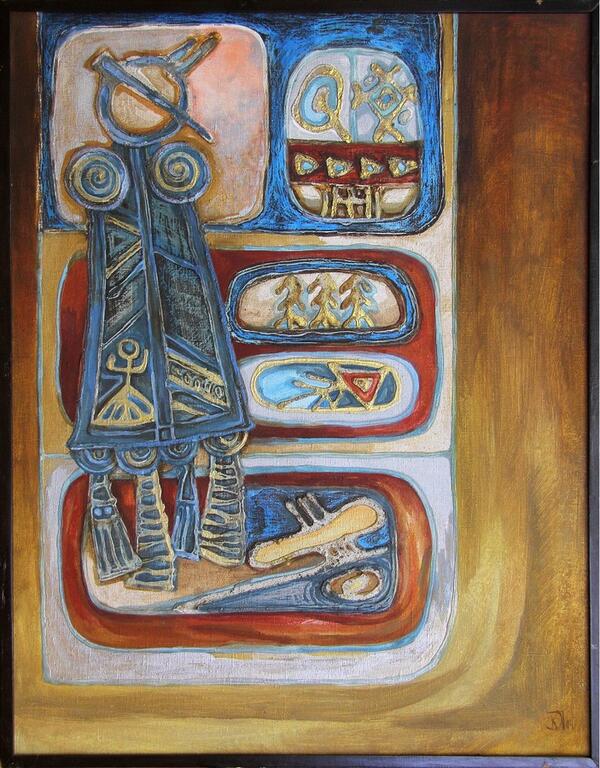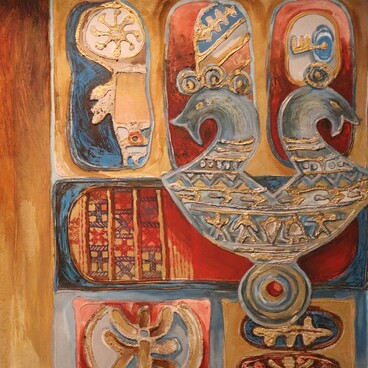In the late 1980s, a new artistic movement, ethnofuturism, began to form in Russian art, specifically among the Finno-Ugric peoples. Representatives of this trend used figurative symbols and depicted religious and mythological plots. The artists mastered new forms in order to portray the traditions and origins of ethnic culture. At the same time, they could mix various modern techniques and introduce non-traditional art materials in their works, for example, fabric or wax.
The ethnofuturists sought to capture the wealth of the national heritage in avant-garde forms, and to convey traditional values to new generations. One of the leading representatives of this movement is the artist Lyudmila Kolchanova-Narbekova, who heads the ethnofuturist creative association “Artoma” and the Mordovian Erzia Museum in Saransk.
The museum’s collection includes the triptych by Lyudmila Nikolaevna “Decorations of the the Mordva People of the Middle Tsna Area”. The texture of the canvas she has created and the elegant color palette in traditional Mordovian tones bridge the three canvases into a single artwork. Thus, the artist thoroughly represents the Mordvin culture.
The left part of the triptych depicts a pendant with stylized horse heads, in the central part there is a torc (a large rigid neck ring) and a round brooch-clasp “syulgam”, in the right part we see a pendant with charms resembling bird’s feet. The latter symbol refers to the cosmogonic myth of the great bird and the emergence of the Mordovian land.
According to the beliefs of the Mordvins, the world arose from the egg of the great bird Inenarmun. The yolk formed the earth, the white formed water, and the shell gave rise to the sky. According to another version of the myth, good spirits appeared from the eggs of Inenarmun to protect people from hostile evil forces.
Like other zoomorphic elements of jewelry, the charms in the shape of bird feet were considered amulets against evil spirits. Archaeological data indicate that animal worship was becoming widespread: rattling pendants, additional charms on rings and necklaces, as well as buckles with images of animals were supposed to give a woman invisible protection.
Creatively rethinking ancient ornaments, symbols and signs, Lyudmila Kolchanova-Narbekova has painted many works in the style of ethnofuturism, for example, the canvases “Winter Bird Inenarmun” in 2006 and “Golden Syulgam” in 2007. The artist has actively promoted the ethnofuturist trend in the national culture of the 21st century.
The ethnofuturists sought to capture the wealth of the national heritage in avant-garde forms, and to convey traditional values to new generations. One of the leading representatives of this movement is the artist Lyudmila Kolchanova-Narbekova, who heads the ethnofuturist creative association “Artoma” and the Mordovian Erzia Museum in Saransk.
The museum’s collection includes the triptych by Lyudmila Nikolaevna “Decorations of the the Mordva People of the Middle Tsna Area”. The texture of the canvas she has created and the elegant color palette in traditional Mordovian tones bridge the three canvases into a single artwork. Thus, the artist thoroughly represents the Mordvin culture.
The left part of the triptych depicts a pendant with stylized horse heads, in the central part there is a torc (a large rigid neck ring) and a round brooch-clasp “syulgam”, in the right part we see a pendant with charms resembling bird’s feet. The latter symbol refers to the cosmogonic myth of the great bird and the emergence of the Mordovian land.
According to the beliefs of the Mordvins, the world arose from the egg of the great bird Inenarmun. The yolk formed the earth, the white formed water, and the shell gave rise to the sky. According to another version of the myth, good spirits appeared from the eggs of Inenarmun to protect people from hostile evil forces.
Like other zoomorphic elements of jewelry, the charms in the shape of bird feet were considered amulets against evil spirits. Archaeological data indicate that animal worship was becoming widespread: rattling pendants, additional charms on rings and necklaces, as well as buckles with images of animals were supposed to give a woman invisible protection.
Creatively rethinking ancient ornaments, symbols and signs, Lyudmila Kolchanova-Narbekova has painted many works in the style of ethnofuturism, for example, the canvases “Winter Bird Inenarmun” in 2006 and “Golden Syulgam” in 2007. The artist has actively promoted the ethnofuturist trend in the national culture of the 21st century.





